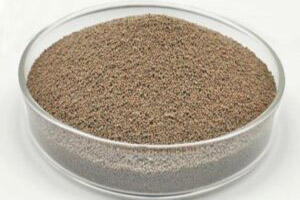The production of bauxite ceramic sand (ceramic sand for oil fracturing proppants) is a meticulous process involving multiple steps, including crushing, grinding, granulation, and high-temperature sintering. The core process is high-temperature calcination, which transforms bauxite into high-strength, corrosion-resistant ceramic particles. The following is a detailed production process flow and key technical highlights:
1. Raw Material Preparation
Bauxite Beneficiation
High-alumina bauxite (first-grade or special-grade) with an Al₂O₃ content ≥75% is used. Impurities such as Fe₂O₃ must be strictly controlled (usually <1.5%).
The raw material is 300-500mm in size and is coarsely crushed in a jaw crusher, then finely crushed in an impact crusher to ≤20mm particles.
Drying and Dehydration
Drying is performed in a fluidized bed furnace (hot air temperature 800-900°C) to a moisture content of <1.5% to prevent sticking to the wall during grinding.
II. Grinding and Ingredients
Closed-Circuit Grinding System
Dried bauxite is mixed with additives (manganese powder, magnesium oxide, etc.) in appropriate proportions and then circulated through a ball mill and a classifier to a size of 500 mesh or larger (particle size ≤30μm).
Function: Improves the reactivity of the raw materials and ensures uniform sintering.
Formula Adjustment
Typical formula: 85-90% bauxite + 5-8% manganese powder + 2-3% binder (such as carboxymethyl cellulose).
Additive Function: Lowers the sintering temperature (from 1500°C to 1150-1250°C) and enhances pellet strength.
III. Granulation
Disc Granulation Method
The powder is added with water (8-10%) and rolled on an inclined rotating disk to form pellets. Particle size is controlled by the water spray rate and disk speed (target 0.5-1.2mm).
Advantages: Excellent pellet roundness, suitable for small- and medium-scale production.
Spray Granulation (Preferred for Industrial Application)
Powder is mixed with water and a dispersant to form a slurry. Atomized through a high-pressure nozzle, the mixture is instantly granulated in a drying tower (for a more uniform particle size distribution).
Parameters: Inlet hot air temperature 400-500°C, outlet temperature 100-120°C.
IV. High-Temperature Calcination (Core Process)
Rotary Kiln Sintering
Temperature Profile:
Preheating (200-600°C): Removes residual moisture and organic matter.
Medium-Temperature (600-1000°C): Dehydroxylation of bauxite (Al₂O₃·2SiO₂·2H₂O → Al₂O₃+2SiO₂+H₂O↑).
High-temperature stage (1150-1500°C): Formation of corundum phase (α-Al₂O₃) and mullite (3Al₂O₃·2SiO₂), imparting high strength.
Kiln atmosphere: Weakly oxidizing (excess air coefficient 1.05-1.10).
Energy-saving technologies
Kiln exhaust gas is used to preheat green pellets (increasing thermal efficiency by over 20%).
Using natural gas/coalbed methane instead of pulverized coal reduces SO₂ emissions.
V. Cooling and Classification
Quick Cooling Process
Kiln-exited ceramsite is rapidly cooled to below 80°C in a rotary cooler (or air quenching) to prevent excessive grain growth and brittleness.
Screening and Classification
Multi-layer vibrating screens classify according to petroleum industry standards:
20/40 mesh (0.45-0.9mm)
30/50 mesh (0.3-0.6mm)
Rejected products (<5%) are returned to the grinding process.
VI. Performance Testing and Packaging
Key Performance Testing
Compressive Strength: ≥86 MPa (Crushing rate <5% at 52 MPa closing pressure).
Acid Solubility: <5% (4% HCl + 3% HF mixture, immersion at 90°C for 30 minutes).
Bulk Density: 1.65-1.85 g/cm³ (Meets API/ISO standards).
Dust-Proof Packaging
Packaged in ton bags (500-1000 kg) or small bags (25 kg), labeled with parameters such as particle size, density, and acid solubility.
Process Difficulties and Solutions
Problem Cause Solution
Particle adhesion rings
Excessive calcination temperature or localized overheating
Optimize kiln speed (0.5-1.5 rpm)
Strength substandard
Insufficient Al₂O₃ content or inadequate sintering
Raise calcination temperature to above 1400°C
Dust pollution
Emissions from the grinding/screening process
Install a pulse bag filter (efficiency >99%)
Applications
Oil fracturing: Accounts for over 80% of global use, propagates fractures and increases oil and gas permeability.
Precision casting: Replaces zircon sand as molding sand, with high temperature resistance up to 1600°C.
Environmentally friendly filter media: Used as a biofilm carrier in wastewater treatment.
This process precisely controls the composition of the bauxite, sintering temperature, and cooling rate to ensure a product with high strength, low density, and corrosion resistance, making it an irreplaceable key material in the oil extraction industry.

